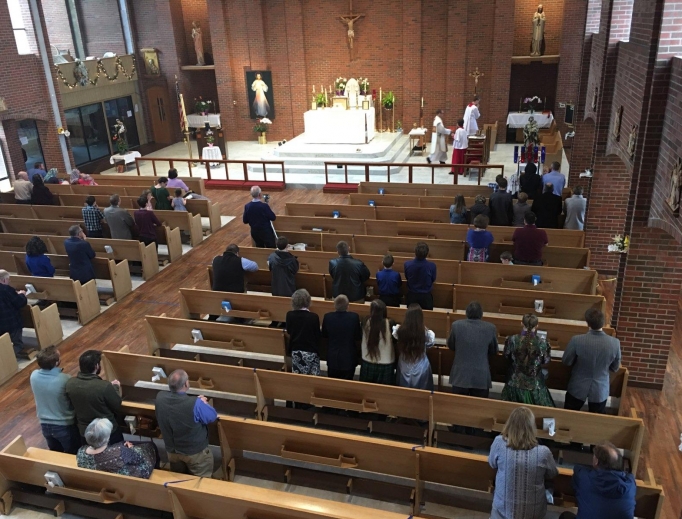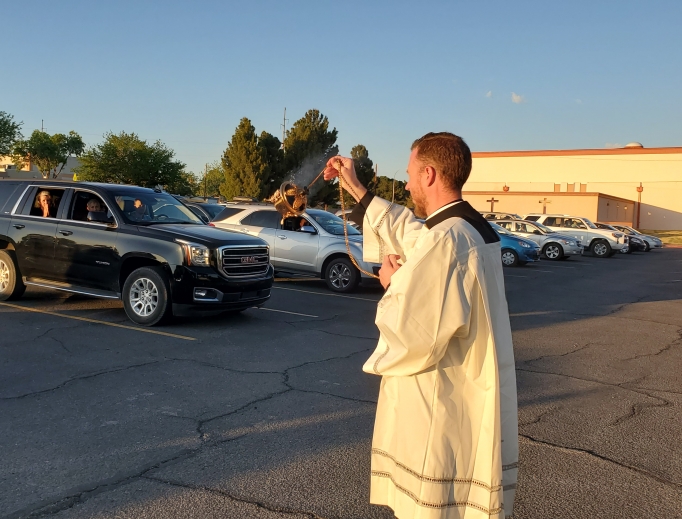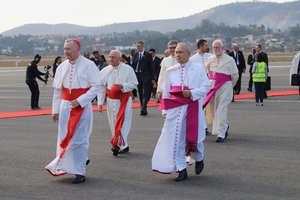Back to Church: Public Masses Resume, With Restrictions
Increasingly, U.S. dioceses are reopening operations.

After the COVID-19 pandemic shut down public Masses and curtailed or eliminated the availability of the sacraments in mid-March, an increasing number of U.S. dioceses have resumed operations, albeit with significant restrictions.
The Diocese of Las Cruces, New Mexico, was the first; others that have followed include Great Falls-Billings and Helena, Montana; Omaha and Lincoln, Nebraska; Portland, Maine; Tyler, Texas; St. Petersburg, Florida; and Denver, with more being added each week.
Public Masses in the Diocese of Great Falls-Billings and Helena resumed April 26. The Montana bishops’ decision to do so, said Darren Eultgen, chancellor of Great Falls-Billings, was in response to Gov. Steve Bullock’s decision to begin a phased reopening of the state.
Phase one included allowing churches to reopen as long as social distancing of 6 feet is maintained between family groups. Eultgen noted, “Both Montana bishops worked closely with the governor to set guidelines.”
Bishop Michael Warfel of Great Falls-Billings made the April 23 announcement to diocesan clergy, but mandated many restrictions. The Sign of Peace is omitted, for example, and the faithful are not allowed to receive the Precious Blood. Communion may only be received in the hand. Collection baskets are not allowed to be passed between parishioners, and there is to be no blessing of oneself with holy water. Social gathering after Mass, such as for coffee and donuts, is forbidden.
Reception of sacraments such as confession is permitted, but with social distancing and proper sanitizing. Infants may be baptized, but with only immediate family and godparents present. New water must be used each time.
The April 26 Sunday Masses in parishes saw an estimated 25% of parishioners return. Despite the availability of public Mass, Bishop Warfel has dispensed the obligation to attend on Sundays and holy days and has requested pastors continue to livestream Mass for vulnerable groups that stay home.

Great Falls-Billings is a mostly rural diocese, with 100 churches, 50 active priests and 35,000 Catholics. Despite the lockdown, Eultgen said, “Our priests have been both creative and courageous in serving our people, even though many are older and hence part of the group more vulnerable to the disease.”
Bishop Austin Vetter of the Diocese of Helena, located on the western side of Montana, asked his parishes to submit reopening plans before resuming public Masses April 26. Twenty-two were initially able to meet and manage safety restrictions and reopened under guidelines similar to Great Falls-Billings; another 28 have since submitted plans for reopening. In a videotaped message to the diocese, Bishop Vetter said not all parishes were yet ready to reopen, but “I ask you good people of God to be patient with us, and with each other, as we start phase one to see how this goes.”
The Diocese of Las Cruces announced April 15 that public celebration of Mass would continue after a monthlong hiatus. Bishop Peter Baldacchino made the decision after hearing reports of “an increase in divorce, drug use and alcohol abuse,” said Christopher Velasquez, a diocesan spokesman. He continued, “[The] bishop also saw the firsthand effects of pandemic-induced anxiety that is intensified from people’s confinement to their homes. [He] knew that people needed the essential good of hope that the Church provides.”

Current regulations mandate that only five people may be present while Mass is being celebrated and that churches must be sanitized afterwards. “Drive-in” Masses are also allowed, provided that a car space be maintained between cars. Priests must wear face masks and gloves for the distribution of Communion. “The glove is to be removed correctly after Communion (glove removed inside out), and afterward it’s placed in a designated container for proper disposal (burning),” Velasquez explained to the Register in an email.
And larger hosts are being used to minimize the chance of hand-to-hand contact. Should this occur, Velasquez said, “our priests are to sanitize their hands and use new gloves before continuing the distribution of Communion.”
Bishop Robert Deeley of Portland, Maine, announced on April 29 that he, too, would permit “drive-in” Masses in parish parking lots, but that the distribution of Communion would not be allowed. Portland parishes have also been offering drive-thru confessions and drive-in adoration.
Bishop Joseph Strickland also allowed public Masses to resume in his Diocese of Tyler, also prompted by the Texas governor’s loosening of restrictions, “provided that health protocols and other measures are observed in order to protect the vulnerable and mitigate the risk of resurgence in our communities.”
He mandated 6-foot separation between families, encouraged the wearing of masks, “strongly recommended” reception of Communion in the hand and asked for regular hand-sanitizing and disinfecting of the churches after Masses.
Archbishop George Lucas allowed public Masses to resume in his Archdiocese of Omaha on May 4; as he is serving as apostolic administrator of the neighboring Diocese of Lincoln, Nebraska, public Masses resumed in Lincoln on May 4, as well. Many of the same restrictions apply. Pastors have been asked to determine how many parishioners they can accommodate at a time observing the 6-foot distancing rules, reported Deacon Timothy McNeil, chancellor.
Public celebration of the other sacraments will resume with restrictions; if the governor further loosens restrictions, other parish activities, such as fellowship and fundraising events, will resume, as well. But Deacon McNeil added, “If a pastor’s parish is located in an area with a high rate of infection, he does not have to open his church for public celebration.”
Public Masses in the Archdiocese of Denver resumed May 9. There are many restrictions in place, however. The numbers allowed into Mass will be fewer, for example, so according to a released statement, “the faithful should not expect to attend more than one or two Masses during the month of May.” As in the other dioceses, the obligation to attend Mass is still suspended, so parishioners are encouraged to attend Mass during the week on other days besides Sundays.
Denver Archbishop Samuel Aquila, in a statement to the Register, said that he hoped that the period of suspension of public Masses has led many to have “a new or greater appreciation for the sacraments [and] that this time of exile, while extremely difficult, will have actually strengthened their faith. Personally, that has been the case for me.”
Public Masses in St. Petersburg, Florida, resumed May 11. Churches will be open for Mass, but only 25% capacity will be allowed, so that social distancing is maintained. Facemasks are required, and the faithful should “consider receiving Holy Communion on the hand.”
Christopher Carstens, director of the Office of Divine Worship for the Diocese of La Crosse, Wisconsin, noted that there are numerous changes within Mass required by medical advice and state regulations, “but one thing remains unchanged during this time, and it is the most essential thing about the Mass — the offering of ourselves with Christ upon the altar. Today’s Roman Missal, citing the Second Vatican Council, sees the faithful joining with their priest in the Eucharistic Prayer as paramount: The faithful must ‘not only offer this unblemished sacrificial Victim but also learn to offer their very selves, and so day by day to be brought, through the mediation of Christ, into unity with God and with each other, so that God may at last be all in all.’”
He concluded, “So even if other elements of the Mass are restricted, this central action remains and should come into clearer focus these days.”
Archbishop Aquila was uncertain when celebration of public Masses would return to normal, “but hopefully we will continue to take steps forward, and more and more people will be able to safely participate in Masses.”
Register correspondent Jim Graves writes from Newport Beach, California.
- Keywords:
- coronavirus
- jim graves
- public masses

















